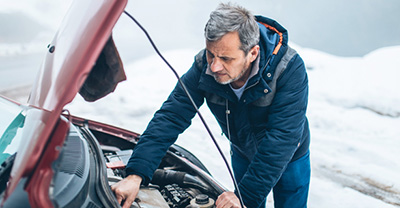6 fall maintenance tips for your car


0 min. read
Fall often brings some unpredictable temperature swings and the potential for hazardous weather. Being proactive with your car in the fall can help prepare it for the harsher weather to come.
The steps you take each year will depend on where you live, especially if your seasons dramatically change from one to the next. For example, while some of us typically see our first snowflakes before Halloween, others may not see regular snow until January—if at all.
If not snow, you may see an increase in rain, fog, or sleet. All of these can make driving more hazardous—especially if you're not prepared. Here are six car maintenance tips to consider this fall.
1. Switch to winter tires

Fall can bring early frost and wet leaves, which can be a very dangerous combination if you’re driving on worn tires. Regular tire maintenance, like tire rotation and monitoring pressure levels, will go a long way toward keeping your tires at peak performance. But it’s wise to take extra precautions in the winter.
If you live in an area that gets snow, winter tires can be a life saver. A review of global studies shows that winter tires consistently outperform summer and all-season tires during winter driving conditions. Making the switch can help keep you safe on winter roads—and extend the life of your summer tires.

2. Check and replace fluids as needed

Vehicles rely on several types of fluid to keep running at optimal performance. Fall is a great time to check up on your car’s fluid levels, address any issues, and top off anything that’s low.
Schedule an oil change if needed and check the dipstick for the oil level between changes.
Some vehicles have a dipstick to check transmission fluid just like engine oil, but others have a more closed system that needs a professional inspection.
Keep your wiper fluid reservoir at least half full—salt and grime can really affect winter visibility, so you’ll probably go through the fluid faster than you do in the summer.
Coolant, also known as antifreeze, is part of your radiator system that cools the engine. Depending on your car, there might be an exterior reservoir where you can see the level, or you might need to open the radiator cap to see if it’s full.
Low brake fluid can cause delayed or inconsistent braking, so be sure the fluid in the reservoir is between the maximum and minimum lines.
Check your power steering fluid level via dipstick or reservoir in the engine bay, depending on your car.
3. Test your battery

As the seasons change, cold weather can strain your car’s battery. An old or weak battery may not start on a chilly day, which can leave you stuck.
First, if your check engine light is on, consult a professional to see what's triggering the warning. But there are some other red flags you can look for to clue you into a weak battery:
If your engine is slow to start or turn over
If your battery is 3 to 5 years old
If your interior or exterior lights are dimmer than normal
If electrical components like heated seats, the phone charger, or the radio aren’t consistently working
You can test your battery at home with a multimeter or take your car to a dealership or auto supply store, who will often test your battery for free.
This can help reduce your likelihood of a dead battery, but it can still happen. Make sure you know how to jumpstart your car so you can go get a new battery.
4. Check your brakes

Your brakes and tires are your first and most significant line of defense when fall roads become slippery. However, if your brake pads and rotors aren't in good shape, you could end up in a dangerous situation. Wear or damage may not show themselves on dry summer roads, so it’s a good idea to check your brakes before conditions change.
If you bring your vehicle in for a tune-up or an oil change, ask the technician to inspect your brakes. To prevent excessive wear, book a brake check every 10,000 miles. Prevention is the best approach here.
5. Inspect and replace wiper blades and light bulbs

Visibility in fall can be challenging if your wiper blades or exterior lights aren't performing well. The days become shorter, so you may need to drive home from work or run your usual errands in the dark. Rain, fog, or snowfall can decrease visibility, so it’s important to make sure you can see everything on the road (new wiper blades, low beams, and high beams) and everyone on the road can see you (brake lights, fog lights, and running lights).
Both of these maintenance tasks are relatively cheap and accessible for the everyday car owner, so keep on them! Even this simple upkeep can help keep you and other drivers safe on the road this fall.
6. Review your car insurance policy

The winter driving season can lead to an increased risk of accidents. However, data shows that 72% of U.S. drivers live in regions where fall is the peak accident season.
Wet leaves reduce traction, making roads slippery like ice. Diminishing daylight means more driving in the dark—when drivers are twice as likely to have an accident than in daylight hours. And, there is often an uptick in deer-related accidents due to the increased movement during fall mating season.

The general information in this blog is for informational or entertainment purposes only. View our blog disclaimer.
*Data accuracy is subject to this article's publication date.










